Addressing the digital divide and building digital literacy: A recap of EduMAX
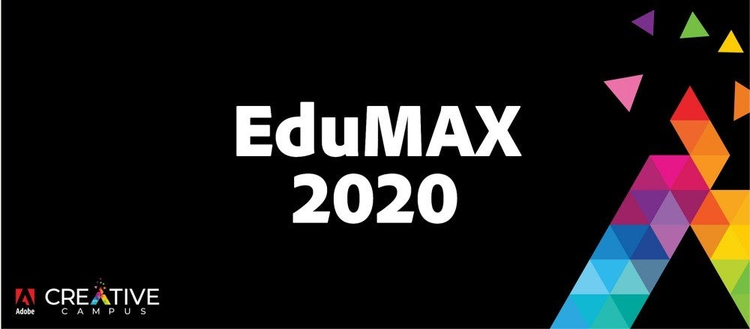
Since convening in Los Angeles last year for Adobe’s annual EduMAX event, the world has changed dramatically, and so has the higher education landscape. With many colleges and universities closing their campuses due to COVID-19 health risks, faculty members, students and families continue to navigate remote and hybrid learning environments. Compounded by events that illuminate the widening social and economic injustices in our society, many colleges have taken steps to incorporate anti-racism teachings into their curricula.
During Adobe EduMAX 2020 — “Together for Student Success through Digital Literacy” — more than 200 university CIOs, deans, provosts, faculty, and staff from around the world convened online to hear from their peers about the innovative ways in which they are integrating digital literacy across disciplines.
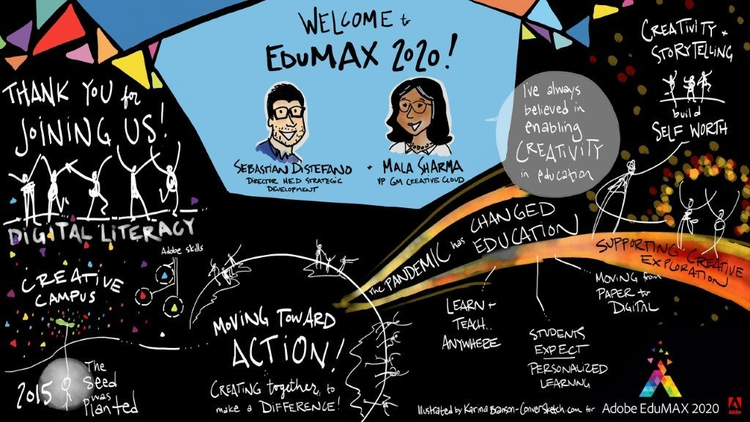
Image by Karina Branson
If you missed the event this year, I’m excited to share a few highlights from EduMAX, including insights from speakers on how colleges are using creative and digital tools to increase student engagement with distance learning, promote social justice, foster equity, and nurture the skills future employers value most.
Bolstering engagement in remote classrooms
The shift to remote learning presents many challenges for colleges that may not be equipped with the right tools to maintain student engagement. These struggles are why Cathy N. Davidson, renowned scholar, educational innovator, and award-winning author, believes the traditional education structure needs to be modified.
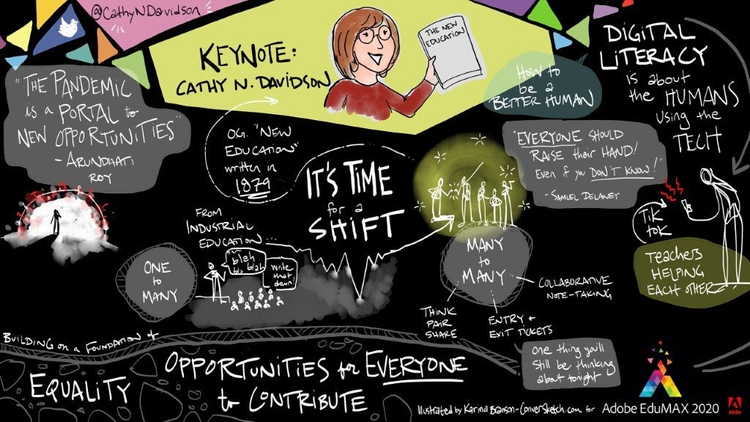
Image by Karina Branson
In her session, titled “The New Education,” Davidson explained that surprisingly minimal changes have been made to the traditional education structure of many academic institutions since it was first implemented in 1869. Amid reoccurring quarantines and ongoing distance learning, she underscores how antiquated and problematic the structure is given how we share information in the digital age.
The need to adjust the classroom was a sentiment also shared by Kyle Bowen, executive director of learning experience at Arizona State University.
“Classrooms are not a natural thing — they don’t exist anywhere else in the universe. We had to create this construct,” Bowen said. “That means we can destroy it and create a new one and forge that future because our students are doing it on their own. They are bringing with them an unprecedented level of technology to their own learning … this is the movement that we can take advantage of and further support our students.”
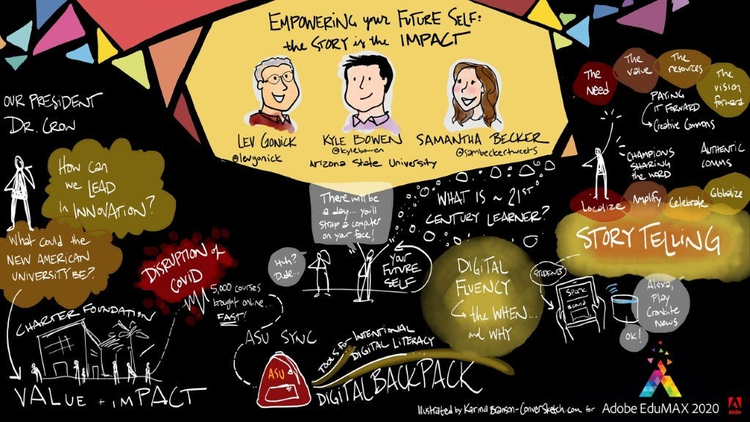
Image by Karina Branson
Arizona State University is an incredible case study. At an Adobe Creative Campus virtual conference earlier this year, Bowen had described how the university evolved to ensure students remained engaged and ultimately built their digital literacy and fluency skills. In fact, more than 3,500 faculty were trained through its program, ASU Sync, which delivers technology-enhanced and fully interactive remote-learning experiences to students using live lectures. The university also made 5,000 courses available online and hybrid to ensure students can enroll in classes wherever they are. Five months later, Arizona State continues to pave the way in innovative teaching and learning practices. The university’s valiant efforts to generate awareness of accessible technology have resulted in a community of students and faculty who share their stories through authentic modalities.
Using digital tools to drive equity in education
In many ways, COVID-19 has widened the aperture to social injustices and disparities in the education system. When Winston-Salem State University — the first Historically Black College and University (HBCU) to become an Adobe Creative Campus — made the decision to transition from on-campus classes to remote learning, it was tasked with ensuring that students would still be able to successfully learn from home. However, Dr. Wanda White, director of the Center for Innovative and Transformative Instruction at Winston-Salem State University, explained during her EduMAX session that this was extremely complex, as many enrolled students came from rural areas without access to high-speed internet.
Dr. White and her team carried forth their commitment to not allow students’ lack of access to digital tools to impact their academic success. The university made strides to provide mobile hotspots so students could attend their classes and complete their coursework. Dr. White and her team also conducted ongoing surveys to ensure they recognized the digital disparities that students faced. This enabled the university to quickly accommodate students with limitations by providing them with the additional digital tools they needed — from laptops to Adobe Creative Cloud — to tell their stories in unique and visually compelling ways, and ultimately develop their digital literacy skills.
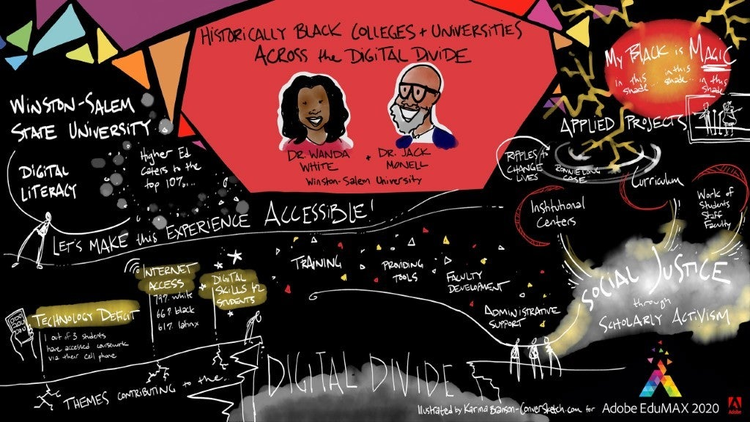
Image by Karina Branson
Additionally, Dr. White and her team recognized how faculty members faced their own challenges with the transition to distance learning. To ensure they would be able to meet students’ needs, faculty who were less familiar with online tools were offered online pedagogy courses over the summer. These courses helped them learn how to integrate tools, such as Adobe Creative Cloud, into their curricula for the upcoming semester. With these laudable efforts in mind, as institutions commit to fostering and sustaining inclusive environments by expanding curricula focused on social justice, they should also explore how to put digital tools at the disposal of students who continue to be disproportionally left out of the digital age.
Bridging the gap between digital literacy and social justice pedagogy
Addressing disparities and social injustices was also a main priority for the University of California, Berkeley, as students and faculty explained the importance of connecting digital literacy with social justice and antiracist pedagogy. During their EduMAX session, “Creative Discovery Fellows (CDF): Amplifying Diverse Voices, Enhancing Teaching and Learning, and Fostering Public Understanding,” attendees learned how UC Berkeley’s CDF approach encourages instructors to incorporate storytelling assignments into the university’s undergraduate social justice curriculum.
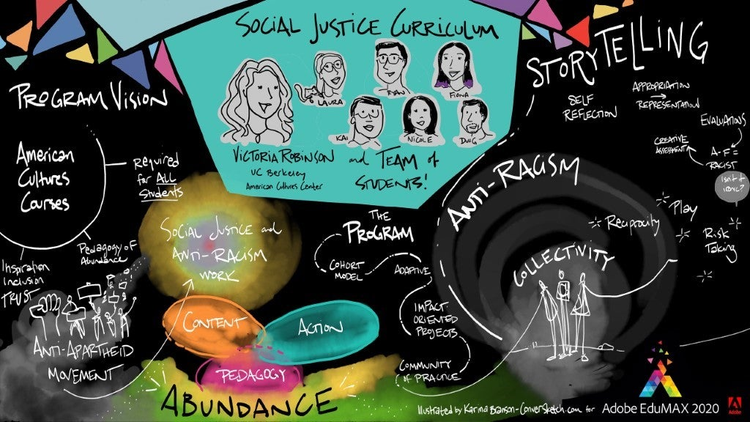
Image by Karina Branson
To ensure that students were more aware of unconscious biases in their presentations, a group of UC Berkeley faculty and staff also created a toolkit for students enrolled in the CDF program, which gave them a deliberate communications strategy that could be applied to their projects. As a result, they incorporated anti-racist and inclusive visuals when using pedagogy tools to share their stories about social-injustice issues.
Nurturing digital skills that employers value
As the job market becomes increasingly competitive, it’s critical for college students to build and showcase the skills — such as critical thinking, collaboration, and problem-solving — that employers look for in job candidates. Research shows that digital skills are invaluable in any profession and can ensure students succeed in their future careers. The Chronicle of Higher Education’s survey of “Employers on Skills, College, and COVID-19” in September 2020 revealed that 97 percent of hiring managers felt it is important that new hires and interns demonstrate digital literacy.
As a parent to a college student, this hits home. When classes moved to remote, my son Matteo applied for a government-funded, co-op program at his university in Canada, which allowed students to work virtually and develop learning programs for other enrolled students. Matteo was accepted into the program, an accomplishment he attributes to showcasing his communications skills and experience using digital modalities in the application process. While enrolled in the program, he applied his creative and computer science skills to create online content, as well as a 28-page Adobe workflow that faculty members could use as a reference tool as they adapted their curricula.
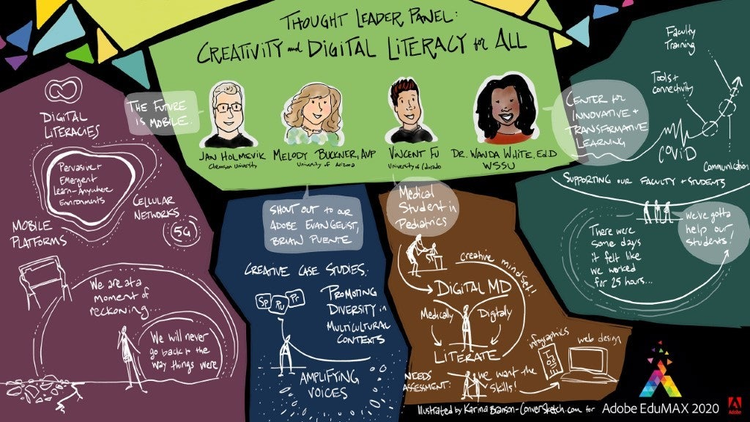
Image by Karina Branson
At EduMAX, several students enrolled in STEM fields shared their unique experiences to illustrate how their digital skills have helped them achieve greater outcomes both academically and professionally. For example, Vincent Fu, a second-year medical student at the University of Colorado – Anschutz now teaches other students how to use Adobe Creative Cloud to help provide more information about the coronavirus pandemic in holistic, visually compelling ways. He had originally learned how to use Adobe Creative Cloud in his youth, and later refined his foundational skills throughout his undergraduate experience at the University of Utah, the first-ever Adobe Creative Campus. It was there Vincent began to think creatively in a nontraditional field, hone his problem-solving skills, and ultimately built digital literacy.
This year has served as an incredible inflection point in education. Amid the irrevocable changes, higher ed leaders and faculty aim to adapt by embracing technology that can increase engagement, adopting strategies to create more equitable learning experiences for all students and nurturing digital and creative skills that employers value most in job candidates. For more information on how to integrate digital literacy across disciplines and throughout curricula, please visit Adobe’s Digital Literacy resources page.